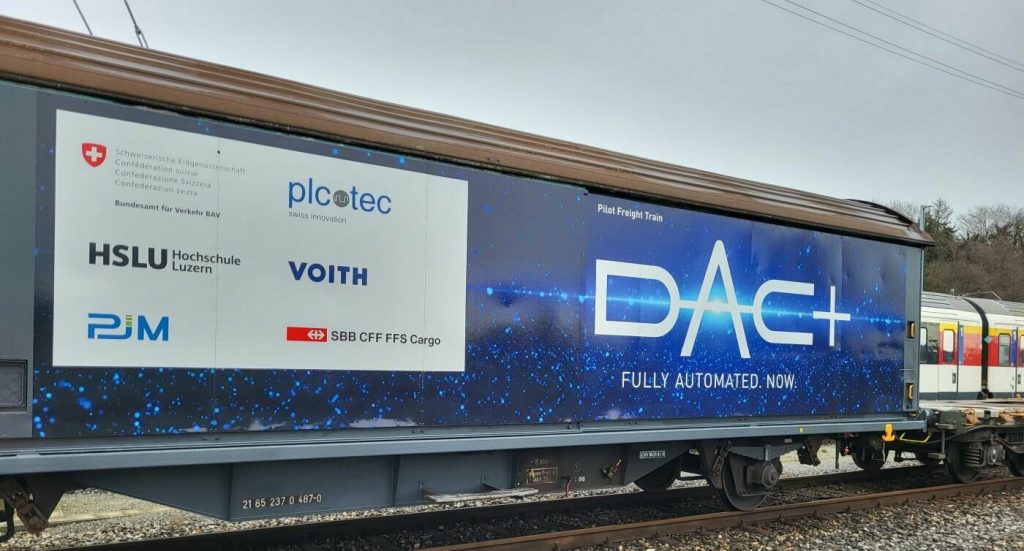 An international consortium consisting of SBB Cargo, Lucerne University of Applied Sciences and Arts (HSLU), and the companies PJM, Voith and plc-tec, launched a Swiss digital freight train pilot (DAC+). The project, which has been set up last year, is implemented with the support of the Federal Office of Transport (FOT).
An international consortium consisting of SBB Cargo, Lucerne University of Applied Sciences and Arts (HSLU), and the companies PJM, Voith and plc-tec, launched a Swiss digital freight train pilot (DAC+). The project, which has been set up last year, is implemented with the support of the Federal Office of Transport (FOT).
The automated freight train is equipped with an automatic coupler, including a digital data line and over the course of a year, various automated functions are now being put to the test. Voith’s CargoFlex automatic coupler, with its mechanical pneumatic connection, has already been in commercial use at SBB Cargo for over three years. Now the focus is on digital automatic coupling, with additional power and data connectivity along the entire convoy.
The test programme with the DAC+ pilot train includes standstill tests of the train, train runs and shunting operations. The pilot train consists of 6 container wagons, which function as test wagons, and a covered wagon as an emulated locomotive, integrating the power supply and the test/measurement equipment for the other wagons.
This test train is used to test the automatic applications, with the exception of the electro-pneumatic braking system.
The tests will take place at various locations, as well as on journeys throughout Switzerland, until the end of 2023. The results of the project flow into the further development of the DAC at the European level. The pilot train is thus making an important contribution to the future of railway freight traffic and to the introduction of digital automatic coupling across Europe. Because in principle, the growing volume of goods can be handled sustainably by rail – provided that railway freight traffic is modernised. This opportunity needs to be taken advantage of now.
At the European level, the development and introduction of digital automatic coupling is being driven forward by several initiatives and development projects. The lead organisations are Europe’s Rail Joint Undertaking (ERJU), the European DAC Delivery Programme (EDDP) and the DAC4EU consortium. National-level initiatives are just as important to the success of the project. Projects are currently under way in various countries to test and further develop digital automatic coupling.
The decision to opt for a uniform type of coupler head was made by the EDDP in autumn 2021. SBB Cargo has done pioneering work, contributing significantly to this development. In previous years, and together with Voith, the company has tested and further developed the selected Scharfenberg coupler head, and is the only rail operator in Europe to have already put it into operation. The first wagons were converted in 2019. This is an example of how the experience gained at SBB Cargo is incorporated into European specifications, norms and standards.
The task at the European level is now to define the technology for data transfer.
There are currently various technologies for energy and data coupling. The solutions, the system architecture of the train, and the subsystems in the digital freight train project (DAC+) are based on the previous results of the EDDP and the DAC4EU consortium, as well as on SBB Cargo’s preliminary work on automatic coupling and its implementation.
One of these technologies is the “Powerline PLUS Train Backbone” (PTB) data link, which connects all wagons and the locomotive(s) via the DAC. Powerline PLUS is a wired communication technology developed by plc-tec and its research partner HSLU. The main advantage is that the data is transmitted along the power cables and plugs, so no additional data cables, electrical contacts or plugs are needed.
The second technology is Single Pair Ethernet (SPE), which does not transmit the data via the power lines but instead via separate data lines and additional electrical contacts in the DAC. An SPE solution optimised for freight services is currently still under development. As soon as such a solution becomes available, the two technologies will be compared with regard to various criteria in a specific test programme.
Share on:





